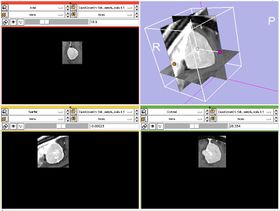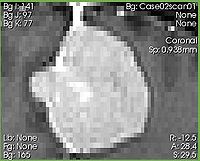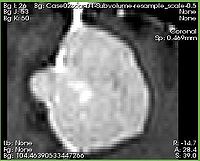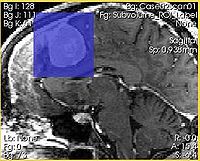Difference between revisions of "Modules:CropVolume-Documentation-3.6"
| (6 intermediate revisions by the same user not shown) | |||
| Line 2: | Line 2: | ||
__NOTOC__ | __NOTOC__ | ||
===Subvolume extraction with ROI widget=== | ===Subvolume extraction with ROI widget=== | ||
| − | + | CropVolume | |
{| | {| | ||
| Line 27: | Line 27: | ||
This module allows to extract rectangular subvolume from a ''scalar'' image, with the subvolume defined by Slicer ROI widget. | This module allows to extract rectangular subvolume from a ''scalar'' image, with the subvolume defined by Slicer ROI widget. | ||
| − | You cannot use this module to crop a DTI volume. | + | You cannot use this module to crop a DTI or DWI volume. |
== Usage == | == Usage == | ||
| Line 38: | Line 38: | ||
===Tutorials=== | ===Tutorials=== | ||
| − | CropVolume (at the time, ExtractSubvolumeROI) is used in the following | + | CropVolume (at the time, ExtractSubvolumeROI) is used in the following tutorials: |
| + | |||
| + | * [http://wiki.na-mic.org/Wiki/index.php/AHM_2010_Tutorial_Contest_-_CoronaryArteriesCenterlinesVMTK Centerline Extraction of Coronary Arteries in 3D Slicer using VMTK based Tools] (winner of the SLC AHM 2010 tutorial contest). Follow the link for the tutorial slides and test data. | ||
| + | * [http://na-mic.org/Wiki/images/3/38/NCIGT2010_RegistrBreakout_Slides_v3_1.ppt Registration Breakout] | ||
| + | * [http://na-mic.org/Wiki/images/4/45/RegLib_C08_Tutorial_PET-CTserial.ppt PET-CT Registration] | ||
| + | * [http://na-mic.org/Wiki/images/5/58/RegLib_C06_BreastCancer_Tutorial.ppt Breast MRI Registration for Cancer Follow-up] | ||
===Quick Tour of Features and Use=== | ===Quick Tour of Features and Use=== | ||
{| | {| | ||
| | | | ||
| + | |||
| + | * '''Tips for efficient use:''' while in the CropVolume module, once ROI has been selected: | ||
| + | ** adjust ROI size by clicking Right mouse button in slice view | ||
| + | ** re-center ROI by clicking Left mouse button in slice view | ||
| + | |||
* '''Input/initialization parameters panel:''' | * '''Input/initialization parameters panel:''' | ||
| Line 56: | Line 66: | ||
* '''Viewing panel:''' Size and location of the ROI can be modified using one of the two methods. First, this can be done in 3D View by moving the colored handles of the ROI widget. Second, the ROI can be adjusted in the slice views. ''Right mouse button click'' adjusts the bounds of the ROI. ''Left mouse button click'' moves the center of ROI to be the point where the click was made. | * '''Viewing panel:''' Size and location of the ROI can be modified using one of the two methods. First, this can be done in 3D View by moving the colored handles of the ROI widget. Second, the ROI can be adjusted in the slice views. ''Right mouse button click'' adjusts the bounds of the ROI. ''Left mouse button click'' moves the center of ROI to be the point where the click was made. | ||
| − | |||
| − | |||
| − | |||
| − | |||
| − | |||
| − | |||
| − | |||
| − | |||
| | | | ||
| Line 79: | Line 81: | ||
|} | |} | ||
| + | |} | ||
| + | |||
| + | |||
| + | {| | ||
| + | | | ||
| + | * '''How can I extract an ROI that is arbitrarily rotated?''' | ||
| + | |||
| + | The input volume and input ROI are both allowed to be under linear transform. This allows to extract a parallelepiped shaped ROI, which is arbitrarily oriented within the input volume using these steps: | ||
| + | |||
| + | # Create a new Transform in the MRML Tree ([[Modules:Data-Documentation-3.6|Data module]]), or in the [[Modules:Transforms-Documentation-3.6|Transforms module]] | ||
| + | # Check the ROI selector in the CropVolume module, note the name, and ''drag the ROI node'' under the created transform in the MRML tree ([[Modules:Data-Documentation-3.6|Data module]]) | ||
| + | # Adjust the rotation of the ROI from the [[Modules:Transforms-Documentation-3.6|Transforms module]] | ||
| + | # Return to CropVolume, use the ROI from above to extract the subvolume | ||
| + | | | ||
| + | [[Image:ExtractSubvolumeROI_ROI_name.jpg|thumb|200px|ROI node in CropVolume]] | ||
| + | |||
| + | |[[Image:ExtractSubvolumeROI_ROI_transformed.jpg|thumb|200px|Same ROI node is under a transform]] | ||
|} | |} | ||
Latest revision as of 20:30, 6 February 2011
Home < Modules:CropVolume-Documentation-3.6Return to Slicer 3.6 Documentation
Subvolume extraction with ROI widget
CropVolume
General Information
Module Type & Category
Type: Interactive
Category: Converters
Authors, Collaborators & Contact
- Andriy Fedorov, BWH
- Ron Kikinis, BWH
- Contact: Andriy Fedorov, fedorov at bwh
Module Description
This module allows to extract rectangular subvolume from a scalar image, with the subvolume defined by Slicer ROI widget.
You cannot use this module to crop a DTI or DWI volume.
Usage
Use Cases, Examples
- CropVolume allows to extract a parallelepiped-shaped subvolume, located arbitrarily within a larger 3D volume. The module allows to control the spacing of the resulting volume, and gives control over the interpolation mode.
- The module is particularly useful in cases when the amount of computation or its complexity can be reduced by limiting the processing to the region of interest.
- The subvolume produced by the module is located precisely in the space of the original image.
Tutorials
CropVolume (at the time, ExtractSubvolumeROI) is used in the following tutorials:
- Centerline Extraction of Coronary Arteries in 3D Slicer using VMTK based Tools (winner of the SLC AHM 2010 tutorial contest). Follow the link for the tutorial slides and test data.
- Registration Breakout
- PET-CT Registration
- Breast MRI Registration for Cancer Follow-up
Quick Tour of Features and Use
|
|
The input volume and input ROI are both allowed to be under linear transform. This allows to extract a parallelepiped shaped ROI, which is arbitrarily oriented within the input volume using these steps:
|
Development
Notes from the Developer
This module wraps the functionality of VTK class vtkImageReslice
Dependencies
ROI Module and Volumes Module.
Tests
Not available at this time.
Known bugs
Follow this link to the Slicer3 bug tracker.
Usability issues
Follow this link to the Slicer3 bug tracker. Please select the usability issue category when browsing or contributing.
Source code & documentation
Source code can accessed here
Links to documentation generated by doxygen.
More Information
Acknowledgment
Supported by Brain Science Foundation.








